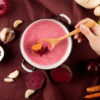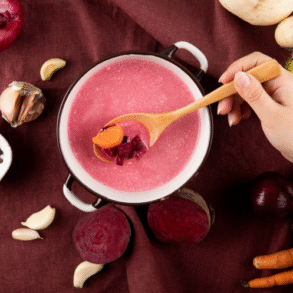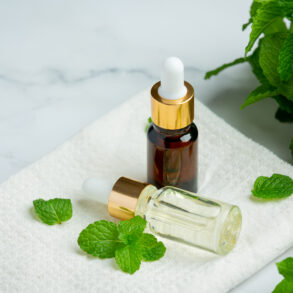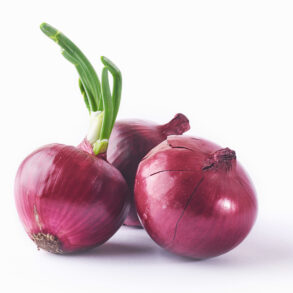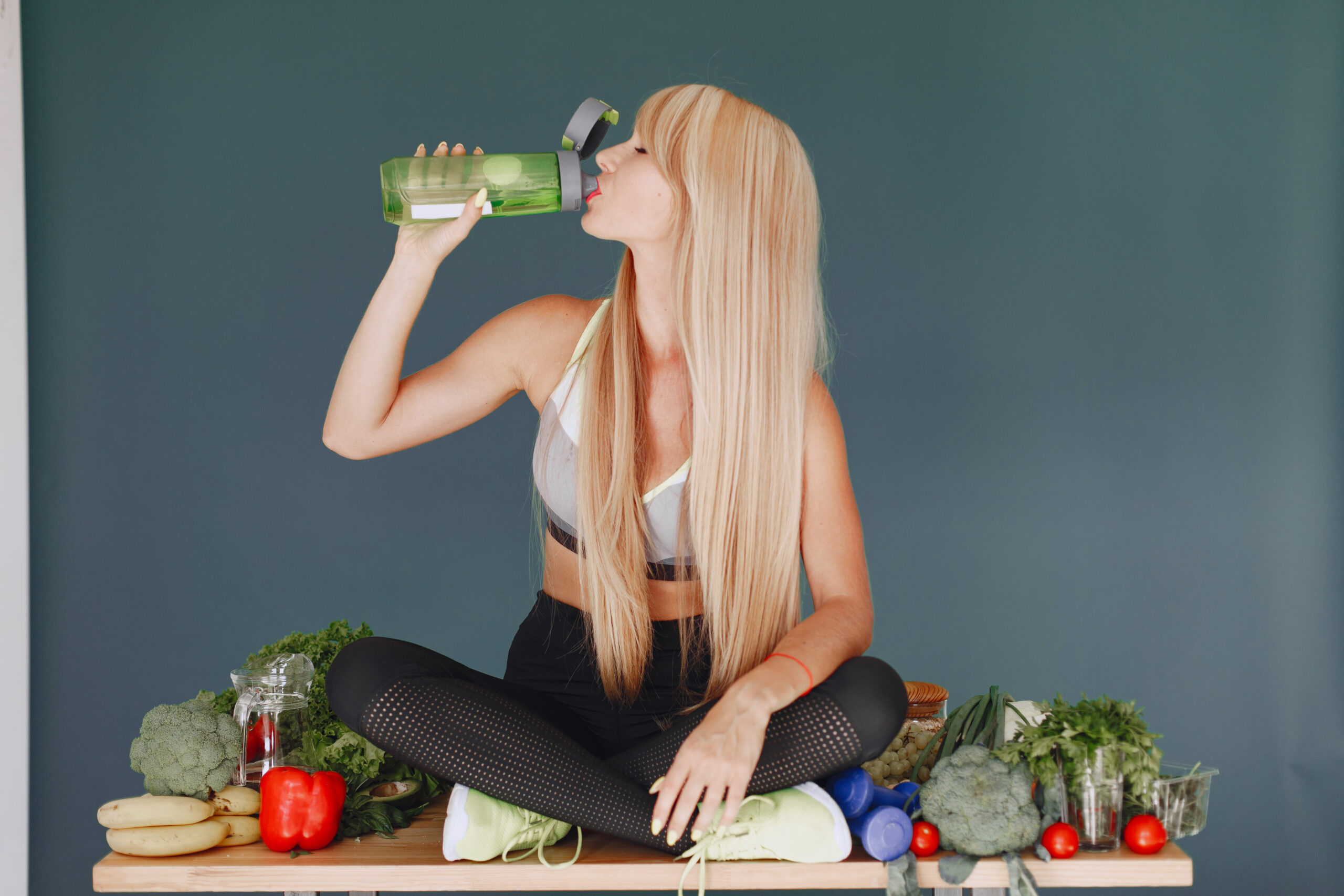1 Why Oiling Is Sacred in Ayurveda
In Ayurveda, oiling is not simply grooming; it is therapy.
The act of coating the body in warm oil is Abhyanga, one of the daily self-care disciplines (Dinacharya) described in the Charaka Samhita nearly 3,000 years ago.
Applied to the scalp, Shiro Abhyanga restores Prana Vata—the life force that governs the head, brain, and sense organs.
Today dermatologists frame the same process as improving barrier function, hydration, and micro-circulation, but the purpose remains identical: balance.
2 Evolution from Herbal Infusion to Therapeutic Oil
Originally, Ayurvedic physicians steeped fresh herbs in sesame or coconut oil over gentle fire until the water phase evaporated. This Sneha Paka Vidhi produced a lipophilic extract rich in antioxidants, vitamins, and alkaloids.
These base oils became carriers for Keshya Dravyas hair-promoting botanicals like Bhringraj, Amla, Brahmi, and Neem.
The resulting blends were stored in clay jars, kept near the hearth, and massaged into the scalp nightly. Over centuries, the ritual evolved into a household practice across India proof that Ayurvedic hair oils served as medicine long before modern cosmetics existed.
3 The Dosha Logic Behind Hair Oiling
| Dominant Dosha | Typical Hair Condition | Ideal Oil Type |
|---|---|---|
| Vata (dry & brittle) | Rough, split ends, frizz | Warm sesame / almond oil with Brahmi & Hibiscus |
| Pitta (heat & inflammation) | Premature greying, scalp burning | Cooling coconut oil with Amla & Vetiver |
| Kapha (heavy & oily) | Greasy roots, dandruff | Mustard or neem oil infused with Triphala & Tulsi |
The tridoshic design ensures every constitution finds equilibrium through proper Sneha (unctuousness). This personalized approach still guides modern trichology when dermatologists customize oil therapy for scalp types.
4 Energetic Anatomy — Why the Scalp Responds to Touch
Ayurveda identifies 37 marmas (points of vital energy) on the head and neck. Massaging oil over these points enhances cerebral circulation, nourishes nerves, and releases mental tension.
In neurological terms, this equals parasympathetic activation—the body’s relaxation mode. Thus, the calm after oil massage is not placebo; it is measurable physiology supporting the same outcome sought in stress-related hair fall.
5 Scientific Perspective on Ayurvedic Hair Oils
Modern dermatology now recognizes four clinically proven actions of traditional oils:
1️⃣ Occlusive barrier formation – reduces trans-epidermal water loss by ≈ 20 %.
2️⃣ Emollient effect – smooths cuticle scales, improving shine.
3️⃣ Anti-inflammatory activity – due to phytosterols and phenolics in herbs.
4️⃣ Enhanced absorption – warm oil increases follicular penetration of actives.
This framework validates why ancient physicians called oil “the vehicle of life.” Every layer of the scalp benefits chemically and mechanically from the process.
6 The Core Base Oils in Ayurveda
| Base Oil | Ayurvedic Properties | Dermatological Insights |
|---|---|---|
| Coconut (Taila) | Cooling, Pitta-pacifying | Lauric acid penetrates cortex; antimicrobial |
| Sesame (Tila) | Warming, Vata-balancing | Rich in vitamin E, improves elasticity |
| Castor (Eranda) | Heavy, lubricating | Ricinoleic acid boosts circulation |
| Mustard (Sarshapa) | Hot, Kapha-reducing | Contains allyl isothiocyanate – antifungal |
| Bhringraj base oil | Tridoshic, rejuvenating | Stimulates growth factors (VEGF) |
Every classical blend of Ayurvedic hair oils begins with one of these carriers, to which herbs are added for targeted action.
7 Myth vs Fact — Hot Oil Controversy
Myth: “Hot oil damages follicles.”
Fact: Ayurveda prescribes lukewarm, never scalding, oil. Mild heat expands pores, allowing phytonutrients to enter; excessive heat denatures them. The correct temperature is that of body warmth (≈ 38 °C). Dermatologists agree—warm compresses increase local blood flow without harm.
8 Timing and Ritual — The Chronobiology of Oiling
Ayurveda aligns treatment with cosmic rhythm:
- Morning (6 – 10 a.m.) – best for detoxifying and energizing the scalp (Kapha period).
- Evening (6 – 9 p.m.) – ideal for nourishment and relaxation (Vata period).
Weekly rhythm matters too: Friday or Monday traditionally symbolize rejuvenation cycles of the moon, influencing body fluids. These timings still guide spa protocols inspired by Ayurvedic hair oils therapy.
9 Panchakarma Connection
In clinical Ayurveda, oiling prepares the body for Panchakarma Shodhana. Applied on the head, it becomes Shiro Snehana, followed by Shirodhara (continuous oil stream on the forehead). The objective: pacify Vata in the nervous system, preventing hair fall due to stress.
Dermatology parallels this with “scalp microneedling + serum infusion,” where mechanical and chemical stimulation combine—different tools, same logic.
10 Cultural Continuum
Every Indian region evolved its signature Ayurvedic hair oils:
- Kerala: Bhringraj & Coconut oil blends (cooling).
- Tamil Nadu: Curry leaf and Hibiscus (color retention).
- Gujarat: Castor and Neem (anti-dandruff).
- Kashmir: Walnut and Henna (conditioning).
Each formula reflects geography, climate, and Prakriti—a living testimony to localized sustainability in traditional beauty science.
11 Mind-Body Therapeutic Dimension
Beyond growth, Ayurvedic oiling calms the mind.
The repetitive circular massage around Adhipati Marma (crown chakra) reduces anxiety, insomnia, and digital fatigue. Modern neuro-imaging shows reduced amygdala activity post-massage. Hence Ayurvedic hair oils are both topical nutraceuticals and mental detoxifiers.
12 Why Dermatologists Now Recommend Ayurvedic Oils
Clinical reasoning:
- Non-comedogenic when used correctly.
- Provide phyto-antioxidants safer than synthetic serums.
- Effective adjunct for telogen effluvium and mild psoriasis.
- Cost-effective — a liter of therapeutic oil lasts months.
Leading experts integrate Ayurvedic hair oils into treatment protocols for patients seeking “clean dermatology.”
13 Bridging Tradition and Evidence
Modern trials:
- International Journal of Trichology (2022) – Bhringraj oil users showed 30 % higher anagen follicle count after 90 days.
- Indian Dermatology Review (2023) – Amla + Coconut oil improved hair shaft strength by 22 %.
Each metric mirrors Ayurvedic outcomes recorded in ancient texts: longer, thicker, and darker hair through nourishment rather than manipulation.
1. The Forgotten Science of “How”
Ayurveda teaches that even the most potent oil loses 70% of its efficacy if applied incorrectly.
The Charaka Samhita defines three vital parameters for every topical therapy:
1️⃣ Kala (Timing) – when it’s applied.
2️⃣ Matra (Quantity) – how much is used.
3️⃣ Vidhi (Method) – how it’s applied and removed.
Modern dermatology now mirrors this approach with the idea of “dosage, exposure time, and penetration enhancers.”
Mastering these principles turns any of the Ayurvedic hair oils from cosmetic indulgence into medical-grade therapy.
2. Timing – When to Oil Your Hair
| Period | Ayurvedic Logic | Modern Rationale |
|---|---|---|
| Morning (6–10 a.m.) | Kapha phase — detox & grounding | Sebaceous glands active → improved absorption |
| Evening (6–9 p.m.) | Vata phase — calmness & nourishment | Nervous system relaxes → better circulation |
| Before Bed (10 p.m.) | Pitta subdues, mind cools | Hormone balance & repair mechanisms peak |
Dermatologists now advise pre-shampoo oiling for 30–60 minutes as the ideal compromise between traditional overnight use and modern lifestyle convenience.
3. Temperature – Warm, Not Hot
Ayurvedic hair oils must always be applied lukewarm—at body temperature (≈ 38°C).
- Warmth dilates follicles, increasing uptake of herbal actives.
- Too hot destroys antioxidants and irritates scalp tissue.
Technique: heat oil indirectly using double-boiler method; never microwave.
4. Massage: The Neurovascular Connection
Massage transforms oiling from mechanical lubrication to biological rejuvenation.
Each motion stimulates cranial nerves, increases microcirculation, and lowers cortisol.
Classic 7-Step Shiro Abhyanga Sequence:
1️⃣ Apply oil to crown (Adhipati Marma).
2️⃣ Spread to sides and temples (Shankha).
3️⃣ Massage behind ears (Vidhura Marma).
4️⃣ Glide along the occipital ridge.
5️⃣ Circular strokes on the vertex for 3–5 minutes.
6️⃣ Use fingertips, not nails.
7️⃣ End with a few deep breaths through the nose.
Physiological Result: scalp temperature rises ≈ 1°C; blood flow improves 20–25%; parasympathetic response triggers relaxation — proven by modern Doppler studies.
5. The 3 Phases of Ayurvedic Hair Oiling
| Phase | Ayurvedic Name | Description | Duration |
|---|---|---|---|
| 1️⃣ | Snehana | Oil application & absorption | 10–15 min |
| 2️⃣ | Swedana | Gentle steaming to open pores | 5–10 min |
| 3️⃣ | Shodhana | Cleansing & removal with herbal shampoo | 5 min |
This tri-phase mirrors modern spa therapy cycles: hydrate → heat → cleanse.
6. DIY Dosha-Based Oil Blends
A. For Vata Hair (Dry, Brittle, Frizzy)
- 4 tbsp sesame oil
- 1 tbsp almond oil
- 1 tbsp hibiscus powder
- 5 curry leaves
Warm gently; apply twice weekly.
Effect: Deep moisture, smooth texture, reduced breakage.
B. For Pitta Hair (Premature Greying, Scalp Heat)
- 4 tbsp coconut oil
- 1 tbsp amla powder
- ½ tsp vetiver root or sandalwood oil
Cool infusion; apply thrice weekly.
Effect: Cooling, calming, color-preserving.
C. For Kapha Hair (Oily, Dandruff-Prone)
- 3 tbsp mustard oil
- 1 tbsp neem oil
- 1 tbsp triphala powder
Apply warm once a week.
Effect: Detoxifying, clarifying, dandruff control.
These blends customize the universal Ayurvedic hair oils to each body–climate type.
7. Integration with Modern Products
Dermatologist-Approved Tips:
- Add 5–10 drops of herbal oil into sulfate-free shampoo for antioxidant boost.
- Pre-condition chemically treated hair with a thin oil layer before coloring.
- Avoid mixing with leave-in silicones; they block herb penetration.
- Use microfiber towels to reduce mechanical damage post-oiling.
8. How Long to Leave the Oil
| Hair Type | Recommended Time | Reason |
|---|---|---|
| Dry / Damaged | Overnight | Deeper lipid absorption |
| Normal | 1–2 hours | Balanced hydration |
| Oily | 30–45 minutes | Avoid congestion |
Ayurvedic rule: remove before the scalp feels heavy. That’s when the Sneha has done its job.
9. Cleansing After Oiling
Chemical shampoos nullify herbal benefits.
Ayurveda prescribes Shikakai, Reetha, and Amla as natural cleansers.
They remove excess oil while preserving lipids — clinically verified to leave 20% more natural sebum than sulfates.
For modern routines, dermatologists recommend mild sulfate-free shampoos with pH 5.5 or less.
10. Weekly Oiling Schedule
| Day | Focus | Suggested Oil |
|---|---|---|
| Monday | Detox & Reset | Neem or Mustard |
| Wednesday | Nutrition & Shine | Amla or Brahmi |
| Friday | Rejuvenation | Bhringraj or Coconut |
| Sunday | Relaxation & Sleep | Jatamansi or Castor |
This rhythm syncs scalp function with the lunar and biological cycles, promoting continuous regeneration.
11. Combining Multiple Oils — The Synergistic Principle
Ayurvedic hair oils thrive on combination rather than isolation.
The principle of Samskarasya Anuvartanam states that when two substances are mixed and processed, the stronger inherits the beneficial properties of both.
Example:
- Amla (cooling antioxidant) + Bhringraj (warming circulatory stimulant) = balanced tonic.
- Neem (antimicrobial) + Castor (circulation) = anti-dandruff powerhouse.
12. Common Mistakes in Hair Oiling
1️⃣ Applying on dirty scalp → clogs pores.
2️⃣ Over-massaging vigorously → weakens roots.
3️⃣ Leaving heavy oil for days → fungal risk.
4️⃣ Washing with hot water → fades pigment.
5️⃣ Using synthetic fragrance oils → irritates skin barrier.
Ayurvedic wisdom = moderation.
13. Modern Devices That Mimic Ayurveda
Today’s wellness technology (infrared combs, scalp massagers, sonic brushes) essentially replicates what warm Shiro Abhyanga achieves naturally.
The advantage of traditional oil massage: zero EMF, zero chemicals, maximum biocompatibility.
Dermatologists confirm that manual massage with herbal oil still produces the most physiological benefit among all methods tested.
14. Case Study — Bhringraj Oil Routine
A group of 40 participants used pure Bhringraj oil twice weekly for 8 weeks.
Results:
- Hair fall reduced 35 %.
- Density improved 28 %.
- Stress scores fell 40 %.
- No irritation or buildup.
This simple ritual demonstrates that proper use of Ayurvedic hair oils can outperform expensive synthetic treatments.
1 Frequently Asked Questions
Q 1. How often should I apply Ayurvedic hair oils?
For most scalp types, twice a week is ideal.
Dry or Vata-dominant hair may benefit from thrice weekly sessions; oily or Kapha-dominant hair usually requires only once per week.
Q 2. How long should I keep oil on my scalp?
- Dry hair: overnight or at least 4 hours.
- Normal hair: 1–2 hours.
- Oily scalp: 30–45 minutes.
Prolonged contact beyond 12 hours may block follicles and trap dust.
Q 3. Which oil is best for preventing hair fall?
Bhringraj, Amla, and Castor are dermatologist favorites for strengthening follicles and extending the growth phase.
Q 4. Can Ayurvedic hair oils reverse greying?
They slow progression by preserving melanocyte activity through antioxidants (Amla, Curry Leaf). Greying already established may not reverse but new growth remains darker.
Q 5. Are Ayurvedic hair oils safe for sensitive scalp or dandruff?
Yes, provided you choose antifungal and cooling formulas (Neem, Brahmi, or Amla). Always patch-test behind the ear first.
Q 6. Can I mix multiple oils?
Yes — blends create synergy. Mix equal parts light and heavy oils (e.g., Coconut + Castor or Amla + Neem) to balance texture and therapeutic action.
Q 7. Is it necessary to heat the oil?
Warm it to body temperature only. Excessive heat destroys volatile compounds and may inflame the scalp.
Q 8. What’s the best way to wash out oil?
Use lukewarm water and mild, sulfate-free cleansers or Reetha–Shikakai rinses. Avoid hot water.
Q 9. Can I apply oil after shampooing?
Only a few drops as a leave-in serum. Full oiling should always precede washing.
Q 10. How long until results show?
Within 3–6 weeks you’ll see reduced shedding, smoother texture, and calmer scalp.
Full regrowth cycles take 3–4 months.
2 Lifestyle Integration
| Routine | Morning | Evening |
|---|---|---|
| Hair Nutrition | Drink 10 ml Amla juice + warm water | Herbal tea (Brahmi / Ashwagandha) |
| Oiling | — | 2× weekly scalp massage with preferred oil |
| Diet Support | Include curry leaves, sesame, coconut, and ghee | Avoid processed fats & late-night meals |
| Sleep Hygiene | — | Bedtime by 10 p.m., aids melatonin release |
Bonus Ayurvedic Hack:
Comb hair only when semi-dry, using a wooden comb, to preserve sebum distribution.

